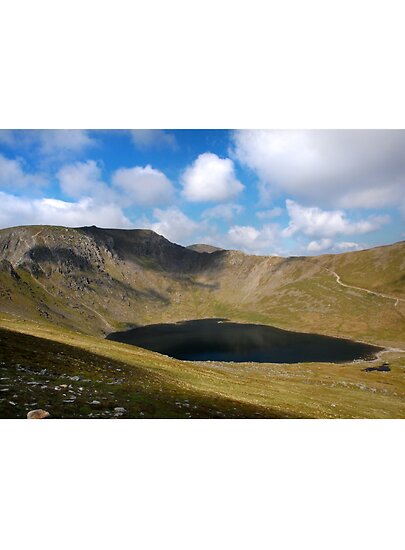Glaciers by Tom
My Blog List
Sunday, 26 September 2010
Glaciers: Then and Now
Glacial evidence in the UK

Snowflakes collect in a hollow. As more snow falls, the snow is compressed and the air is squeezed out to become firn or neve. With the pressure of more layers of snow, the firn will, over thousands of years, become glacier ice. Erosion and weathering by abrasion, plucking and freeze-thaw action will gradually make the hollow bigger.
Even though the ice is trapped in a hollow and unable to move down hill, gravity will still encourage it to move. This circular motion is known as rotational slipand can cause the ice to pull away from the backwall creating a crevasse or bergschrund. Plucked debris from the backwall causes further erosion through abrasion which deepens the corrie.
Some of this debris is deposited at the edge of the corrie, building up the lip.
These processes create a characteristic rounded, armchair shaped hollow with a steep back wall.
When ice in a corrie melts, a circular lake is often formed at the bottom of the hollow.
This description ts taken from BBC Bitesize, where there is also a diagram demonstrating the formation of a corrie.
http://www.bbc.co.uk/schools/gcsebitesize/geography/glaciation/glacial_erosionrev1.shtml
Key Term Art
Monday, 23 August 2010


- Funky snowflake: Jump up and down pretending to be fluttering downwards.
- Ice: Jump into position as if on a snowboard and shout "ice"
- Basal slippage: Wiggle your hips in a circular motion.
- Corrie: Make a cutting action across your body with a cupped hand.
- Arête: Make a cutting action downwards.
- Pyramidal peak: Thrust your arm in the air.
For example: Snow falls and compacts to form ice. The ice erodes the rock by basal slippage to create a corrie. Two corries together form an arête, and three corries together form a pyramidal peak!
What landforms of erosion will disappearing ice reveal? - Main Activity
Also here is the website for the Kung- fu glacier game:
Sunday, 25 July 2010
Glacier system and Key Vocabulary

This Systems Diagram is taken from S-cool revision website and shows the key Inputs, Processes and Outputs, which occur in glaciation.
Ablation - The melting of the ice, mainly during summer months, and usually at the snout end of the glacier.
Accumulation - The build up of the glacier due to snow being compacted into ice.
Calving - The splitting of the end of the glacier into smaller sections. These could become icebergs, if the glacier snout ended in the sea. .
Glaciation - The effect of large masses of ice on the landscape. Compressed snow accumulates to eventually form ice and create a glacier.
Ice Sheets - These are large masses of ice which cover an entire land surface. Antarctica is the best example as the ice sheet covers the entire continent.
Snout - the lower end of the glacier.
Valley Glaciers - The most common of the two types of glacier. These are confined by the valley sides that have already been carved out by a river. Valley glaciers can be found in all the main mountain ranges of the world, such as the Franz Josef Glacier in the Southern Alps of New Zealand, and the Rhone Glacier in Switzerland.
Tuesday, 13 July 2010
Introduction to Glaciers
Monday, 5 July 2010
My first blog - Introduction
I'm Tom, I live in Leicester and am going onto do my PGCE teacher training for Geography Secondary school in september at the University of Leicester.
Over the summer I am hoping to learn as much as I can about glaciation. I have never really studied in great depth before, and so I'm quite looking forward to it. At the moment my knowledge is relatively low, but I can tell you now, snow and ice are involved, and I know Fjords are an outcome after the glacier has gone. So over the next couple of months, I hope to learn a lot more regarding the subject.
Look forward to reading other peoples blogs and speak to you all soon
Tom
